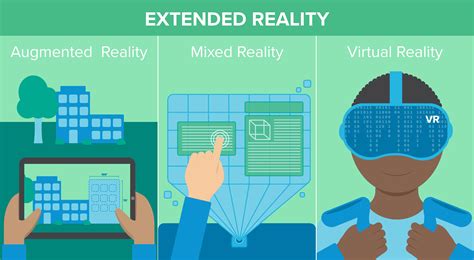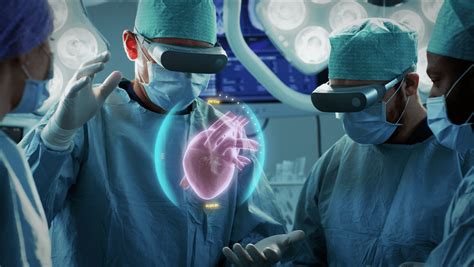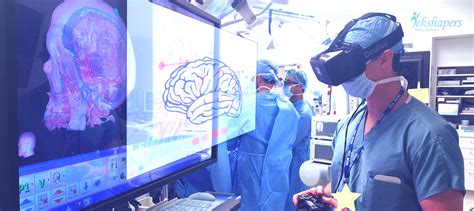Breaking News


Popular News


Discover the application, benefits, and challenges of using augmented reality in medical education. Explore the future possibilities of AR in medical training.In recent years, advancements in technology have revolutionized the way we learn and teach. One such innovation, augmented reality (AR), has increasingly gained attention in various fields, including medical education. This blog post will explore the use of augmented reality in medical training, its applications in the healthcare industry, and the potential benefits and challenges associated with its implementation in medical curriculum.
The introductory section will provide an overview of augmented reality and its significance in medical education. Subsequently, we will delve into the application of AR in medical training, highlighting its role in anatomy visualization, surgical simulations, and patient interaction. Additionally, we will discuss the potential benefits that AR offers in enhancing learning experiences and improving patient care.
However, with every innovation comes a set of challenges. We will also address the obstacles and limitations of integrating AR into medical education. Finally, we will contemplate the future of augmented reality in medical training and its potential to revolutionize the healthcare industry. Join us as we navigate through the fascinating world of AR in medical education.
Contents

Augmented Reality (AR) is a technology that superimposes digital information such as images, videos, and 3D models onto the real world environment. Unlike virtual reality, which creates an entirely immersive experience, AR enhances the existing environment by adding virtual elements to it. This technology has gained significant attention in recent years due to its potential applications in various industries, including medical education.
One of the key components of AR is its ability to provide an interactive and immersive learning experience. In the medical field, AR can be used to create realistic simulations of human anatomy, medical procedures, and surgical operations. This allows medical students to gain hands-on experience and practice in a safe and controlled environment. Additionally, AR can provide real-time feedback and guidance, enhancing the learning process and improving the retention of knowledge.
Furthermore, the use of AR in medical education can bridge the gap between theoretical knowledge and practical skills. By visualizing complex medical concepts and processes, AR can make learning more engaging and understandable for students. It can also enable educators to tailor the learning experience to the individual needs of each student, leading to a more personalized and effective education.
In summary, the introduction of Augmented Reality in medical education holds great promise for revolutionizing the way future healthcare professionals are trained. By leveraging the interactive and immersive nature of AR technology, educators can enhance the learning experience, improve student outcomes, and ultimately contribute to the advancement of medical knowledge and practice.

Augmented Reality (AR) is revolutionizing the way medical professionals are trained. By integrating digital information and virtual objects into the real world, AR technology provides a highly immersive and interactive learning experience for medical trainees. In medical training, AR can be used to simulate surgical procedures, provide 3D visualizations of anatomical structures, and offer interactive training modules for practicing clinical skills.
One of the key applications of AR in medical training is the use of AR-enhanced simulators. These simulators allow medical students to practice surgical procedures in a realistic and risk-free environment. By superimposing virtual images onto physical objects, AR simulators enable trainees to perform hands-on surgical tasks, such as suturing and laparoscopic surgery, with real-time feedback and guidance.
Another important application of AR in medical training is the visualization of complex anatomical structures. With AR technology, medical students can view 3D models of the human body and explore internal organs and systems in a way that is not possible with traditional textbooks or 2D images. This interactive and immersive learning experience helps students gain a deeper understanding of anatomy and physiology, leading to better retention and application of knowledge in clinical practice.
Overall, the use of AR in medical training holds great potential for enhancing the education and preparation of future healthcare professionals. By providing realistic and interactive learning experiences, AR technology is helping to bridge the gap between theory and practice, ultimately leading to better-trained and more competent medical professionals.

One of the major benefits of Augmented Reality (AR) in medical education is its ability to provide students with realistic and immersive learning experiences. By using AR technology, medical students can interact with virtual 3D models of the human body, allowing them to gain a deeper understanding of anatomical structures and physiological processes. This hands-on approach to learning can greatly enhance students’ retention of information and their ability to apply their knowledge in real-world clinical settings.
Another benefit of AR in medical education is its potential to improve patient outcomes. With AR-enabled simulation training, medical students can practice performing complex medical procedures in a safe and controlled environment. This not only helps them develop and refine their skills, but it also reduces the risk of errors and complications when they begin working with actual patients. As a result, the use of AR in medical education can ultimately lead to better quality of care and improved patient safety.
In addition, AR technology can help bridge the gap between theoretical knowledge and practical application. By overlaying digital information onto the physical world, AR can help students understand how medical concepts apply in real clinical scenarios. For example, AR can be used to simulate the effects of different drugs on the body, allowing students to see the physiological changes that occur in real time. This can enhance their critical thinking and decision-making skills, preparing them to make sound clinical judgments when treating patients.
Furthermore, the use of AR in medical education can contribute to increased student engagement and motivation. Traditional teaching methods can sometimes be dry and monotonous, but AR has the potential to make learning more interactive and enjoyable. By incorporating gamification elements, such as quizzes and challenges, AR can help keep students actively involved in their learning process, leading to improved retention and mastery of medical knowledge.

One of the main challenges of incorporating Augmented Reality (AR) into medical curriculum is the cost associated with the technology. AR hardware, software, and training can be expensive, making it difficult for medical schools and institutions to invest in this advanced educational tool. Additionally, the need for regular updates and maintenance further adds to the financial burden, making it a significant obstacle for widespread adoption.
Another challenge is the lack of standardized curriculum and guidelines for integrating AR into medical education. With varying levels of expertise among faculty members and diverse learning objectives, there is a need for comprehensive guidelines on how to effectively incorporate AR into existing medical curriculum. Without clear direction, educators may struggle to maximize the potential of AR in enhancing the learning experience for medical students.
Furthermore, resistance to change from traditional teaching methods presents a considerable challenge in implementing AR in medical education. Faculty members and administrators may be reluctant to embrace new technologies and shift away from traditional lectures and textbooks. Overcoming this resistance requires comprehensive training and support for educators to effectively integrate AR into the curriculum and demonstrate its value in enhancing the educational experience.
In addition, the technical complexity of AR systems and the learning curve for educators pose a challenge in the implementation process. Training faculty members to use AR technology proficiently and incorporating it seamlessly into the curriculum requires time and resources. Overcoming these technical challenges is essential to ensure the successful integration of AR into medical education.

Augmented Reality (AR) has made significant strides in the field of medical education, and its future potential is nothing short of groundbreaking. As technology continues to advance at a rapid pace, the integration of AR in medical education is only expected to grow in prominence.
The benefits of AR in medical education are already evident, allowing students to engage in immersive learning experiences. The interactive nature of AR facilitates better understanding and retention of complex medical concepts, giving students a more hands-on approach to learning.
As the application of AR in medical education becomes more refined and accessible, the challenges of implementing this technology will gradually diminish. Advancements in AR hardware and software will lead to more seamless integration into medical curriculums, ultimately revolutionizing the way medical education is delivered.
The future of AR in medical education holds great promise, offering educators and students innovative tools to enhance learning and ultimately improve patient care. With the continued development of AR technologies, the potential for immersive, interactive, and personalized learning experiences in the medical field is limitless.

What is augmented reality (AR)?
Augmented reality is a technology that overlays digital information such as images, videos, or 3D models onto the real world, enhancing the user’s perception of their environment.
How is augmented reality used in medical education?
AR is used in medical education to provide immersive learning experiences, simulate medical procedures, and visualize anatomy in 3D.
What are the benefits of using augmented reality in medical education?
Some benefits include enhanced student engagement, improved spatial understanding of anatomical structures, and the ability to practice complex procedures in a risk-free environment.
Are there any drawbacks to using augmented reality in medical education?
Challenges include the cost of technology, potential technical issues, and the need for faculty training to effectively integrate AR into the curriculum.
Can augmented reality improve patient outcomes in healthcare?
AR has the potential to enhance medical training, improve diagnostic accuracy, and facilitate preoperative planning, ultimately contributing to better patient care.
What are some examples of augmented reality applications in medical education?
Examples include AR-based anatomy learning tools, surgical simulation platforms, and applications for visualizing medical imaging data in 3D.
What does the future hold for the use of augmented reality in medical education?
The future likely involves further advancements in AR technology, increased adoption in medical training programs, and the development of new applications for clinical practice and patient care.